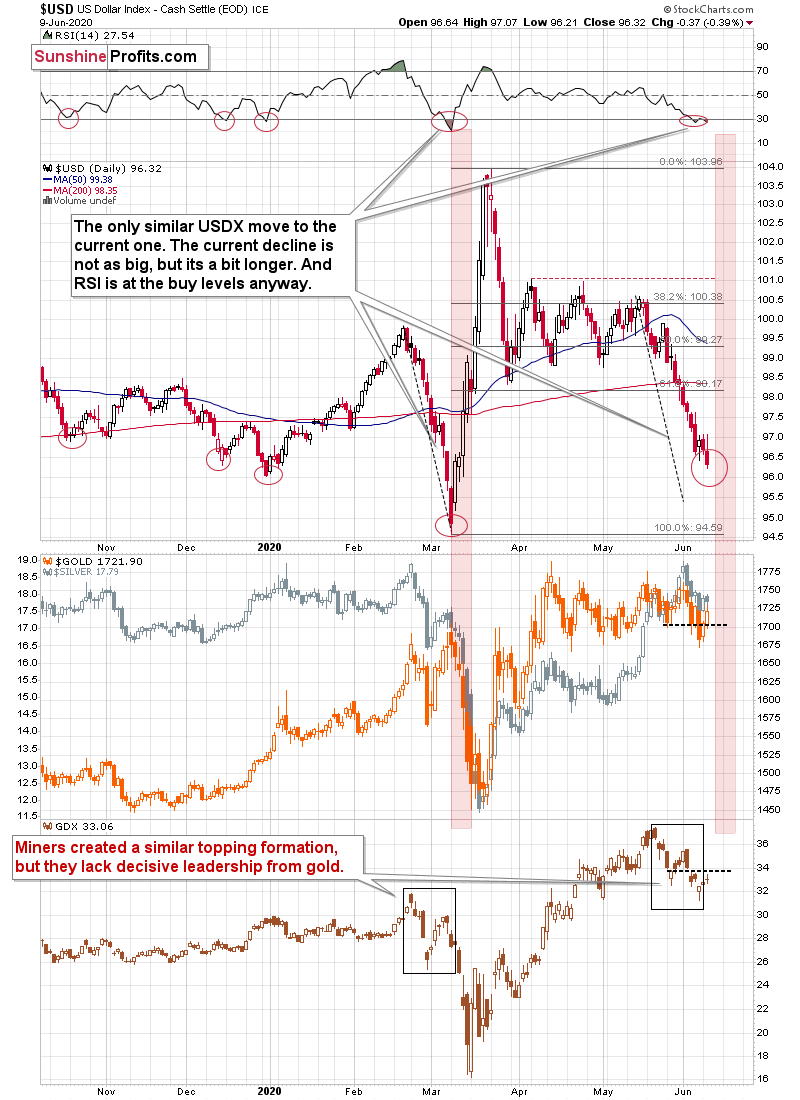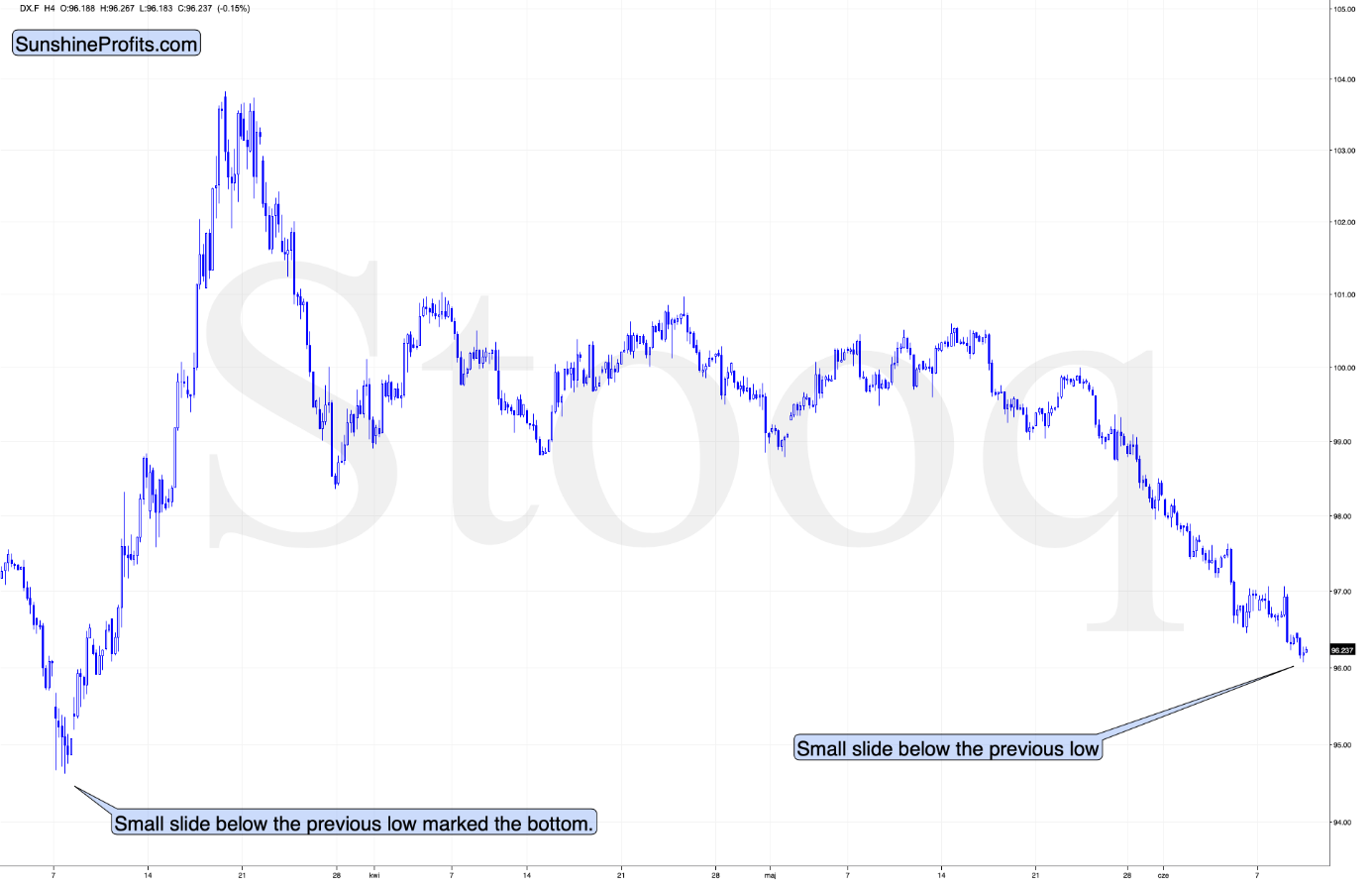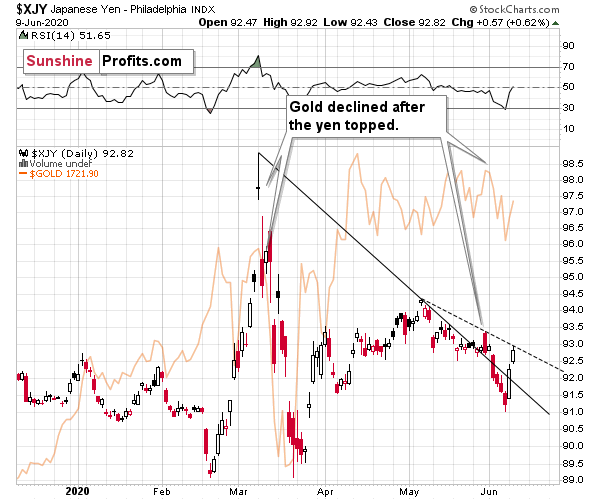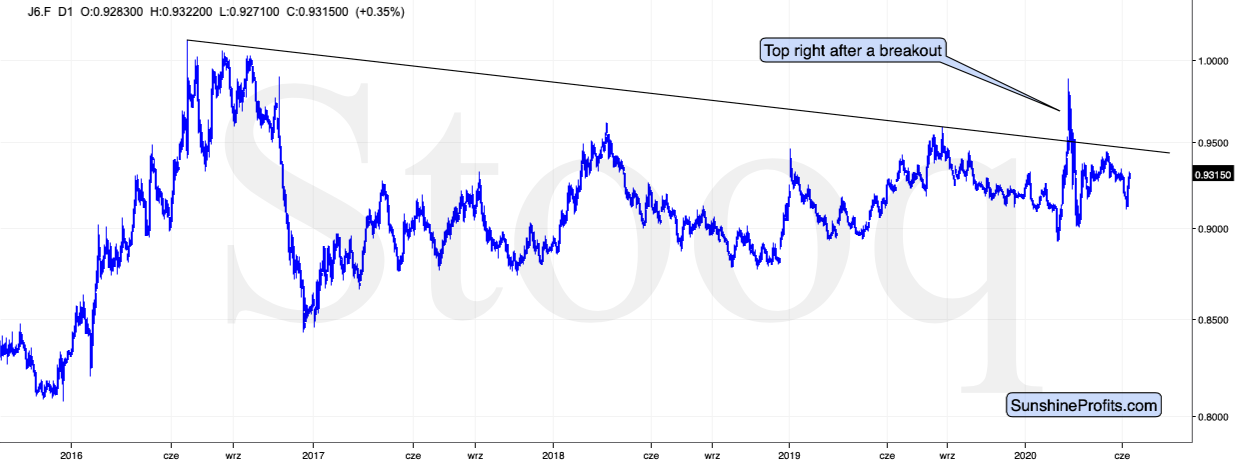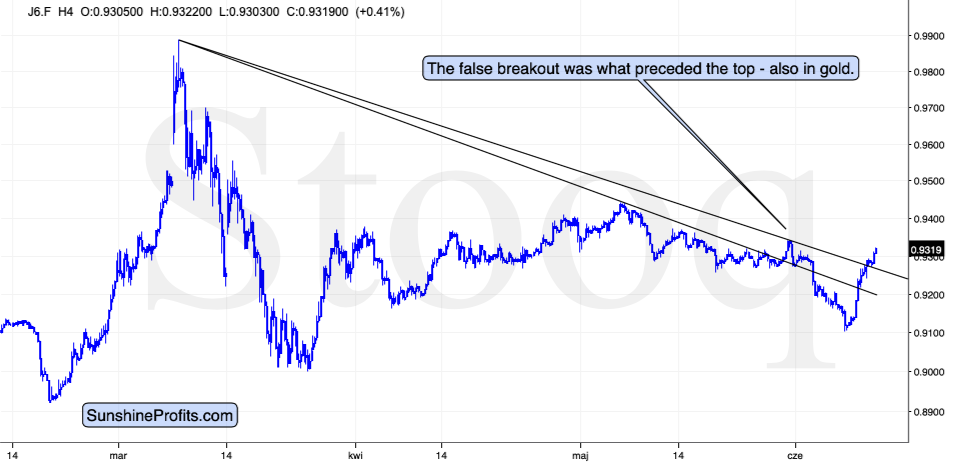Briefly: in our opinion, full (250% of the regular position size) speculative short positions in mining stocks are justified from the risk/reward point of view at the moment of publishing this Alert.
Gold moved higher once again yesterday, and so did gold stocks. And - also once again - gold miners moved up only barely, while the move up in gold was much more visible. All that happened while the USD Index became even more oversold as it moved lower.
Both above-mentioned relative signs are important, and both are bearish.
Gold is not moving to new monthly highs (not even close!), despite USD's move to new June lows.
Gold miners are underperforming gold to a considerable extent. The dashed lines on the above chart help to compare yesterday's closes in gold and GDX to the May low (closing price). Gold just closed visibly above it, while GDX closed visibly below it.
Both markets are showing weakness relative to the market that should make them move higher in a more meaningful way. This is a double-bearish confirmation.
Moreover, as far as mining stocks are concerned, please note that the areas that we marked with rectangles in the GDX part of the chart (bottom), are identical in terms of price and time. The initial size of the decline in case of both the February decline and the recent one, was almost identical. In terms of time, the previous pattern was faster, so it's no wonder that this time miners managed to form two corrective upswings instead of one that was bigger.
What does this similarity in the miners tell us? It tells us that miners are ripe for sliding once again. They lack the leadership from gold, which is probably the only reason why they are declining only steadily.
And gold is lacking leadership from the USD Index, which just keeps falling to more extremely oversold levels on a daily basis. Yet, the odds now strongly favor a rebound in the latter, which means that gold is very likely to slide soon.
Let's take a look at USD's 4-hour chart for extra detail.
The March decline ended when the USD Index first bottomed after a sharp rally, then moved back up, and then declined a bit below that initial low. There were two sharp declines in the USDX - one yesterday and one on June 4. The USDX moved a bit up after the initial bottoms and it moved to new lows just a few hours ago. If it rallies from here, it might confirm that the final bottom is in.
Looking at one specific part of the USD Index (the USD - yen exchange rate) provides us with more details.
Gold topped along with the Japanese yen, which took place after yen's fake slide lower and then after its rally and a breakout above the declining resistance line. The line above which the yen had broken, is clearer on the chart below:
The yen had also moved above the declining short-term resistance line (visible on the previous chart) in late May and that's also when gold topped. Yesterday, the yen moved to the declining dashed resistance line and in today's pre-market trading it moved above it.
That's yet another breakout.
The yen broke also above the resistance line based on the March and late-May highs. This breakout is analogous to the breakout in late-May, when the yen had broken above the line that was based on the March and early-May highs. The previous breakout was actually a bull trap and it was an indication of gold's top. It could be the case that the current breakout is a bull trap as well. At least that's what mining stocks' weakness suggests.
What if the USDX Keeps Declining?
Naturally, it's emotionally easiest to be bearish right at the bottom as everything looks bleak (and that's precisely why it's a bottom), so many are probably wondering what happens to PMs if the USD Index just keeps declining.
In this case, gold will probably continue to move back and forth until the USD Index finally does rebound. Even if the U.S. dollar is to go much lower, it will not go down in a straight line. And when it rebounds, gold would be likely to plunge - just as it reversed a little recently and gold did slide during the day. Then, it would be important to monitor the strength of gold's reaction toward USD's next decline. If gold then soars back - or better yet - rebounds despite the upward correction in the USDX still taking place, then it will indicate that we should no longer expect gold to decline in the next several weeks (but we would likely be able to get out profitably, anyway).
The above is unlikely, and one of the reasons is USD's long-term breakout that was verified several times. That's why we keep featuring it in our weekly flagship Alerts - it's important not to lose focus on this key piece of the puzzle. The medium-term trend for the USD Index is up. Please keep in mind that things don't have to be perfect in the USA for the USD to rally. The demand for the dollars has to exceed the demand for other major currencies, most importantly the euro and the Japanese yen. The latter is being printed in vast amounts and the EU has or will have multitude of its own problems (Brexit, anyone? Or maybe some sovereign debt crisis that could be looming given the recent Covid-19 stimuli?).
Summary
Summing up, the tops in gold, silver, and mining stocks appear to be already in, and the decline is likely to accelerate shortly. The outlook for the precious metals market is bearish for the next few weeks, and it's very bullish for the following months. Even if gold, silver, and mining stocks are not going to move to new 2020 lows, they are still likely to decline visibly when the USD Index soars.
After the sell-off (that takes gold below $1,400), we expect the precious metals to rally significantly. The final decline might take as little as 1-3 weeks, so it's important to stay alert to any changes.
Most importantly - stay healthy and safe. We made a lot of money on the March decline and the subsequent rebound (its initial part) price moves (and we'll likely make much more in the following weeks and months), but you have to be healthy to really enjoy the results.
As always, we'll keep you - our subscribers - informed.
To summarize:
Trading capital (supplementary part of the portfolio; our opinion): Full speculative short positions (250% of the full position) in mining stocks is justified from the risk to reward point of view with the following binding exit profit-take price levels:
Senior mining stocks (price levels for the GDX ETF): binding profit-take exit price: $10.32; stop-loss: none (the volatility is too big to justify a SL order in case of this particular trade); binding profit-take level for the DUST ETF: $231.75; stop-loss for the DUST ETF: none (the volatility is too big to justify a SL order in case of this particular trade)
Junior mining stocks (price levels for the GDXJ ETF): binding profit-take exit price: $9.57; stop-loss: none (the volatility is too big to justify a SL order in case of this particular trade); binding profit-take level for the JDST ETF: $284.25; stop-loss for the JDST ETF: none (the volatility is too big to justify a SL order in case of this particular trade)
For-your-information targets (our opinion; we continue to think that mining stocks are the preferred way of taking advantage of the upcoming price move, but if for whatever reason one wants / has to use silver or gold for this trade, we are providing the details anyway. In our view, silver has greater potential than gold does):
Silver futures downside profit-take exit price: $8.58 (the downside potential for silver is significant, but likely not as big as the one in the mining stocks)
Gold futures downside profit-take exit price: $1,382 (the target for gold is least clear; it might drop to even $1,170 or so; the downside potential for gold is significant, but likely not as big as the one in the mining stocks or silver)
Long-term capital (core part of the portfolio; our opinion): No positions (in other words: cash
Insurance capital (core part of the portfolio; our opinion): Full position
Whether you already subscribed or not, we encourage you to find out how to make the most of our alerts and read our replies to the most common alert-and-gold-trading-related-questions.
Please note that the in the trading section we describe the situation for the day that the alert is posted. In other words, it we are writing about a speculative position, it means that it is up-to-date on the day it was posted. We are also featuring the initial target prices, so that you can decide whether keeping a position on a given day is something that is in tune with your approach (some moves are too small for medium-term traders and some might appear too big for day-traders).
Plus, you might want to read why our stop-loss orders are usually relatively far from the current price.
Please note that a full position doesn't mean using all of the capital for a given trade. You will find details on our thoughts on gold portfolio structuring in the Key Insights section on our website.
As a reminder - "initial target price" means exactly that - an "initial" one, it's not a price level at which we suggest closing positions. If this becomes the case (like it did in the previous trade) we will refer to these levels as levels of exit orders (exactly as we've done previously). Stop-loss levels, however, are naturally not "initial", but something that, in our opinion, might be entered as an order.
Since it is impossible to synchronize target prices and stop-loss levels for all the ETFs and ETNs with the main markets that we provide these levels for (gold, silver and mining stocks - the GDX ETF), the stop-loss levels and target prices for other ETNs and ETF (among other: UGLD, DGLD, USLV, DSLV, NUGT, DUST, JNUG, JDST) are provided as supplementary, and not as "final". This means that if a stop-loss or a target level is reached for any of the "additional instruments" (DGLD for instance), but not for the "main instrument" (gold in this case), we will view positions in both gold and DGLD as still open and the stop-loss for DGLD would have to be moved lower. On the other hand, if gold moves to a stop-loss level but DGLD doesn't, then we will view both positions (in gold and DGLD) as closed. In other words, since it's not possible to be 100% certain that each related instrument moves to a given level when the underlying instrument does, we can't provide levels that would be binding. The levels that we do provide are our best estimate of the levels that will correspond to the levels in the underlying assets, but it will be the underlying assets that one will need to focus on regarding the signs pointing to closing a given position or keeping it open. We might adjust the levels in the "additional instruments" without adjusting the levels in the "main instruments", which will simply mean that we have improved our estimation of these levels, not that we changed our outlook on the markets. We are already working on a tool that would update these levels on a daily basis for the most popular ETFs, ETNs and individual mining stocks.
Our preferred ways to invest in and to trade gold along with the reasoning can be found in the how to buy gold section. Additionally, our preferred ETFs and ETNs can be found in our Gold & Silver ETF Ranking.
As a reminder, Gold & Silver Trading Alerts are posted before or on each trading day (we usually post them before the opening bell, but we don't promise doing that each day). If there's anything urgent, we will send you an additional small alert before posting the main one.
Thank you.
Sincerely,
Przemyslaw Radomski, CFA
Editor-in-chief, Gold & Silver Fund Manager


